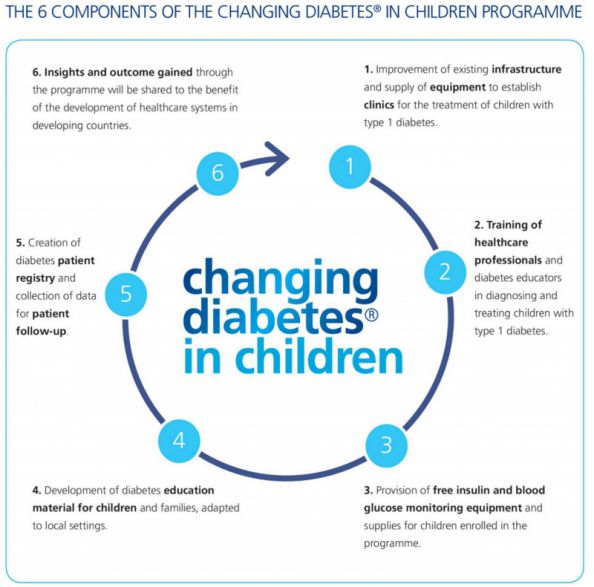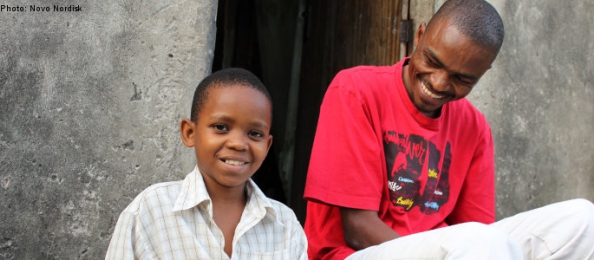Changing The Lives of 10,000 Children
Living with type 1 diabetes is challenging – even more so for children in developing countries, where having diabetes puts their lives at even greater risk.
Persons with type 1 diabetes must adhere to daily injections of insulin to replace the insulin that their pancreas is unable to produce. Self-discipline – including sticking to a balanced diet and monitoring blood glucose levels – is essential to preventing dangerously high or low blood sugar levels. On top of all this, persons with type 1 diabetes need to make sure they get regular exercise.
For a child with type 1 diabetes, parents and healthcare professionals are essential to support their health and well-being. But in many parts of the developing world, this support is hard to come by.
As the world leader in diabetes care, Novo Nordisk saw a need to leverage its competences and responsibility to take action. In 2009, the company launched the Changing Diabetes® in Children program to improve the lives of children with type 1 diabetes in developing countries. In March 2013, the program surpassed its 2015 goal of enrolling 10,000 children. Today, thousands of children are receiving the support and treatment they need to live normal, healthy lives.
| Initiator | Novo Nordisk |
| Project start | 2009 |
| Status | ongoing |
| Region | worldwide |
| Contact person | Scott Dille, Camilla Crone Jensen |
| Awards |
Project benefit
- Establishing clinics
- Training of healthcare professionals
| Anti-Corruption | - |
| Business & Peace | - |
| Development | - |
| Environment | - |
| Financial Markets | - |
| Implementing UNGC Principles in your Corporate CSR Management | - |
| Human Rights | X |
| Labour Standards | - |
| Local Networks | - |
| Advocacy of global issues | - |
| Business opportunities in low income communities/countries | - |
| Project funding | - |
| Provision of goods | X |
| Provision of services/personal | X |
| Standards and guidelines development | - |
Diabetes in children
Type 1 diabetes is a lifelong disease that often occurs at a young age, and its prevalence is rapidly increasing in children and adolescents in many countries. The International Diabetes Federation estimates that there are 490,000 children under the age of 15 years with type 1 diabetes in the world. Around half of them live in developing countries.
In the developing world, there is a high mortality rate for those with childhood diabetes. In sub-Saharan Africa, the life expectancy for a child with newly diagnosed type 1 diabetes is typically less than one year.
Barriers to proper care for children in developing countries
Diagnosing type 1 diabetes is the first crucial step. But in the developing world, healthcare professionals are lacking awareness about the symptoms that can lead to neglected cases or misdiagnosis. In many cases, the symptoms of type 1 diabetes in children resemble symptoms of common acute medical conditions encountered in many developing countries, such as cerebral malaria.
For the family, having a child diagnosed with diabetes can bring an overwhelming financial and emotional burden. The cost of necessary treatment and care often exceeds a family’s annual income. In some cases children are abandoned by the family as they are forced to make the difficult choice between feeding their other children and using the income on treatment.
Unfortunately, lack of awareness and the cost of treatment are not the only barriers. Great distances and insufficient travel options in rural areas make it difficult for families to seek medical care. Medical facilities, when reached, are short of medical equipment, supplies, and cold-chain storage for insulin.
To bring down the barriers, healthcare professionals require better knowledge about diagnosing and treating diabetes in children, care facilities must be accessible and well supplied, and insulin and education materials must be made available to the children and their families.

The Changing Diabetes in Children® program
For the Changing Diabetes® in Children program, Novo Nordisk works with national and international partners to provide immediate relief for children with type 1 diabetes and their families. Looking beyond immediate relief, the program builds lasting and long-term support through the establishment of clinics and training of healthcare professionals.
Since 2009, diabetes clinics have been established in nine countries: Bangladesh, Cameroon, Democratic Republic of Congo, Ethiopia, Guinea, India, Kenya, Tanzania, and Uganda. Within each country, a number of satellite access points have been set up to offer diabetes monitoring and treatment. The whole hub-and-spoke system is coordinated at a central point in each country.
Children in the program receive free insulin, glucometers, and strips – a service that continues for the duration of the program. The program gives major support to both the diabetes clinics and the satellite access points. Both are provided with medical equipment – including glucometers and strips – as well as storage facilities for medical supplies, with the support to set them up correctly. The clinics are given appropriate registry systems – developed by Novo Nordisk for recording blood glucose (HbA1c) and other monitoring data – and the training to use it. Data produced in this way is an invaluable source of information about the state of diabetes in these countries and how it is being controlled. It will contribute to an improved understanding of the practical extent of the problem and ensure that individual children are given access to desperately-needed treatment throughout the course of their illness.
An important milestone reached
The goal set for the Changing Diabetes® in Children program was to enroll 10,000 children by the end of 2014. As of March 2013, reports from the nine countries revealed that the total number of children receiving treatment and care had passed 10,000 – a little more than a year ahead of time.
Today 10,119 children have been enrolled and a total of 77 clinics have been established to treat and care for children with type 1 diabetes. Education efforts have resulted in 2,700 trained healthcare professionals who are better equipped to diagnose and treat children with type 1 diabetes and to provide education and support to their families.
The Changing Diabetes® in Children program supports the rights of children with type 1 diabetes and their families to access the facilities and medical care that provides health and well-being. Through the program, Novo Nordisk aims to strengthen efforts to achieve Millennium Development Goal 4 by doing its part to reduce child mortality.
Ensuring the long-term sustainability of the program
The current Changing Diabetes® in Children program is expected to proceed until the end of 2014. Novo Nordisk is currently working on a sustainability plan for the program, in consultation with all involved partners, to identify ways to ensure the continuation of the provision of diabetes care for children on a country-by-country basis.
John’s story
John Kijazi from Tanzania is an 11-year-old boy with a typical story to tell.

At the very last minute, John was brought to the diabetes center at Muhimbili Hospital. Before coming there, he was wrongly diagnosed at his local clinic, where they treated him for malaria. Today, John is enrolled in the Changing Diabetes® in Children program and benefits from free weekly checkups at the diabetes center, glucometers, strips, and insulin. He has been receiving treatment for almost two years now.
Last year, however, family members convinced John’s father to try traditional healing. He paid more than three months’ salary for John to drink a cup of herbal tea believed to cure all chronic diseases. After days without insulin, John felt ill and decided to take matters into his own hands. He spent his school money on a bus ticket to the diabetes center. Here, the nurse managed to get John stabilized and at the following visit, the nurse educated John’s father on the importance of insulin for the sake of his survival. Since then, John has taken his insulin every day.
This project description was originally presented in the Global Compact International Yearbook 2013.
Scott Dille is Communications Manager at the Corporate Sustainability department of Novo Nordisk.
Camilla Crone Jensen works as Project Coordinator, Corporate Sustainability at Novo Nordisk.
Write a comment about this page
Your comments are provided by your own free will and you take sole responsibility for any direct or indirect liability. In order to maintain the highest discussion quality, all comments will be reviewed by our editors. You hereby provide us with an irrevocable, unlimited, and global license for no consideration to use, reuse, delete or publish comments in accordance with our Community Guidelines.
About Us // Privacy Policy // Copyright Information // Legal Disclaimer // Contact
Copyright © 2012-2018 macondo publishing GmbH. All rights reserved.
The CSR Academy is an independent learning platform of the macondo publishing group.









